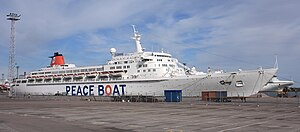SS Oceanic (1963)

Oceanic in Helsinki, June 2009
|
|
| History | |
|---|---|
| Name: |
|
| Owner: |
|
| Operator: |
|
| Port of registry: | |
| Builder: | Cantieri Riuniti dell' Adriatico, Monfalcone, Italy |
| Cost: | $40 million |
| Yard number: | 1876 |
| Launched: | 15 January 1963 |
| Acquired: | March 1965 |
| In service: | 31 March 1965 |
| Identification: | IMO number: 5260679 |
| Status: | Sold for scrap, June 2012 |
| General characteristics (as built, 1965) | |
| Type: | cruise ship |
| Tonnage: | |
| Length: | 238.44 m (782 ft 3 in) |
| Beam: | 29.42 m (96 ft 6 in) |
| Draught: | 8.60 m (28 ft 3 in) |
| Installed power: |
|
| Propulsion: | Two propellers |
| Speed: |
|
| Capacity: | 1,600 passengers (maximum) |
| Crew: | 560 |
| General characteristics (as rebuilt, 2000) | |
| Tonnage: | 38,772 GT |
| Decks: | 10 (passenger accessible) |
| Speed: | 18 knots (33 km/h; 21 mph) service speed |
| Capacity: | 1800 passengers (maximum) |
| Crew: | 565 |
| Notes: | Otherwise the same as built |
SS Oceanic was a cruise ship owned and operated by Peace Boat. She was built in 1965 by Cantieri Riuniti dell' Adriatico, Monfalcone, Italy for Home Lines. Between 1985 and 2000, she sailed for Premier Cruise Line under the names Starship Oceanic and Big Red Boat I, before being sold to Pullmantur Cruises and reverting to her original name. In 2009 she left the Pullmantur fleet for Peace Boat.
Oceanic was the first newbuilt ship ordered by Home Lines. She was ordered from the Cantieri Riuniti dell' Adriatico shipyard at Monfalcone, Italy. She was designed as a combined two-class ocean liner and one-class cruise ship, running line voyages from Cuxhaven, Southampton, and Le Havre to Canada during the northern hemisphere summer and cruising during the winter.
According to William H. Miller's book, Greek Passenger Liners, the main designer behind the ship was in fact Home Lines' executive vice president, Charalambos Keusseuglou, who drew up the plans together with Mr. Costanzi, who had designed the SS Galileo Galilei and SS Guglielmo Marconi of Lloyd Triestino. The ship included many forward-looking features that are still included in present-day cruise ships, such as a magrodome covering the pool area, and life-boats located not on the top of the ship, but on separate lifeboat bays, lower on the hull.
...
Wikipedia
